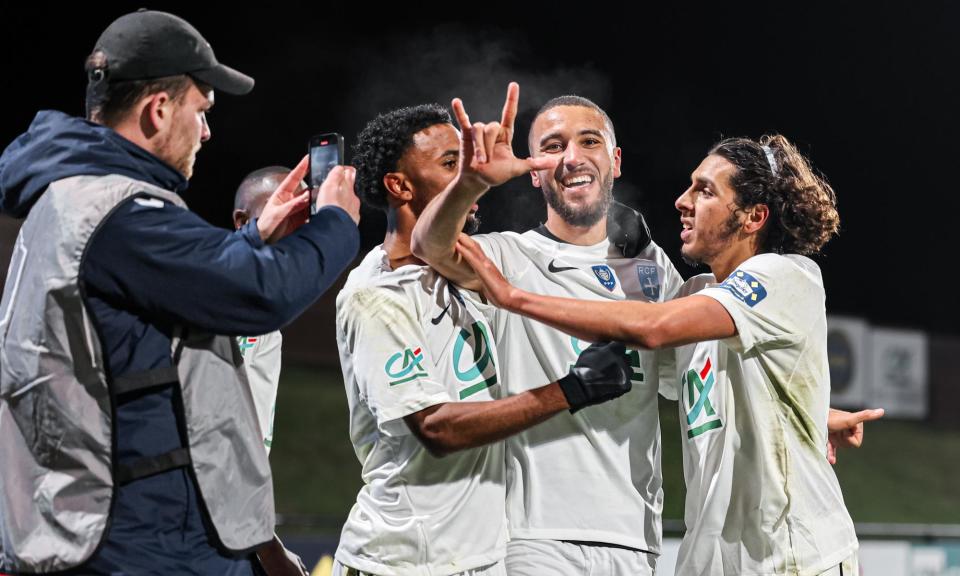What happened to Racing Club de France – and could they be on their way back?

The Coupe de France has a habit of producing eccentric storylines. From long-haul away trips for teams in far-flung overseas regions to finals involving fourth-division sides, the largest domestic cup competition in the world is never short of unlikely encounters.
And despite Sunday’s last-32 fixture between fourth-tier Racing Club de France and top-flight Lille looking like another of those ties at first glance, the match-up is in fact one of the cup’s storied rivalries. The Paris-based side’s cup wins in 1945 and 1949 saw them beat Les Dogues in both finals, with Lille winning the trophy three consecutive times in between. This weekend, the two clubs meet again after 75 years of vastly differing fortunes.
Racing were one of the founders of France’s professional league back in 1932, and have five Coupe de France titles to their name – the first coming in a 1936 domestic double. Since the mid-century glory days, though, they have undergone a dozen name changes as well as multiple mergers, liquidations, stadium moves and relegations to the depths of amateur football.
A rebirth in the 1980s as Matra Racing, bankrolled by businessman Jean-Luc Lagardère and featuring the likes of David Ginola and Enzo Francescoli, would end in chaos as the investor pulled out at the end of the decade. Their run to the 1990 Coupe de France final would serve as a swansong before the team plummeted back to lower-league obscurity for the next 30 years.
Now, after myriad financial struggles around the turn of the century, the now-independent football branch of France’s oldest multi-sports club – founded in 1882 – is cautiously looking to find its footing again.
Racing have been coached since 2019 by Guillaume Norbert, a former Arsenal youth team player who went on to play for Lorient, Angers and Nantes. His father Patrick - a former actor and film producer - took up the presidency the year before, having previously been at the helm at Angers.
Under their guidance, Racing were promoted back to the fourth-tier National 2 in 2022, having narrowly missed out in the previous two Covid-shortened campaigns. After a poor start this season, consecutive wins have placed them back in the race for promotion to the third division, after finishing second in their pool last season.
The coach describes the mood in the ciel et blanc camp as one of “excitement” – at the chance of playing a regular in European competition, but even more so at the opportunity to qualify for the last 16. The 43-year-old jokingly brushes aside the suggestion that preparations for the game have kept him busier than usual, pointing out that he runs a construction company once he’s done coaching in the mornings – “every week is busy, you know!”
The long-term project, Norbert explains, is to build the club back up to professional status: “At the beginning, the first team was training three times a week in the evenings, since all the players had jobs on the side – nowadays, that’s the case for very few of them and we have sessions every morning. We’ve got a physio, a goalkeeping coach, and new sponsors that have been coming in – it really feels like we’re on the right track.”
The club’s strong youth development record is a major source of pride - the likes of William Gallas and Louis Saha are notable alumni. Emerging prospects are usually rapidly snapped up by neighbouring clubs who have their own academies, unlike Racing. The club’s reputation as a prolific development club remains, though, and its teams compete in the regional first division of every age group – an impressive achievement at semi-professional level.
Despite their renewed ambition, Racing are still faced with logistical headaches. Sunday’s cup tie is, nominally, a home game. However, the Stade Yves-du-Manoir, in the western suburb of Colombes, is being renovated this season to host the hockey tournament at this summer’s Olympics. The council-owned stadium, which also hosted events during the 1924 Games, is the team’s historic home ground, which they finally returned to in 2012 after bouncing from one suburb to another as a result of various mergers.
This season, the first team mostly plays their league matches in nearby Boulogne-Billancourt instead. More stringent stadium regulations for cup fixtures and two-weeks notice had left the club scrambling to find a venue for the Lille game. With no options in the capital, Racing head to Chambly, just beyond the Paris region’s borders - the very team they beat with a stoppage-time winner in the previous round.
Next year should spell the end of the stadium moves, as the club finally touch down on solid ground and move into the Yves-du-Manoir for good. As Norbert points out, the refurbished facilities will provide a firmer base from which to develop the firstteam, and anchor the club’s youth development efforts.
While the national-scale attention that comes with facing Ligue 1 opposition is likely to be fleeting, the high-profile tie serves as an early indicator that the club is moving in the right direction. With the prospect of French football’s third tier turning fully professional on the horizon, Racing may have the opportunity of finally securing long-term stability after decades of turmoil. But for now, the focus is on Lille.

 Yahoo Sport
Yahoo Sport 



































































